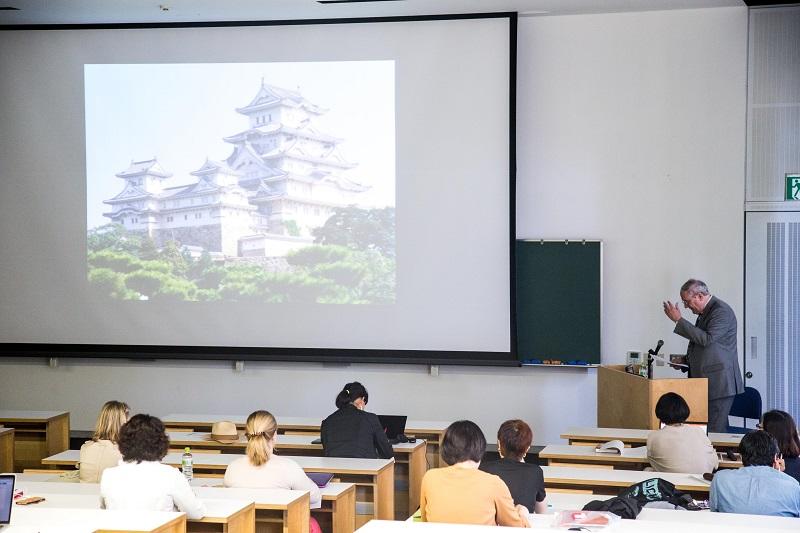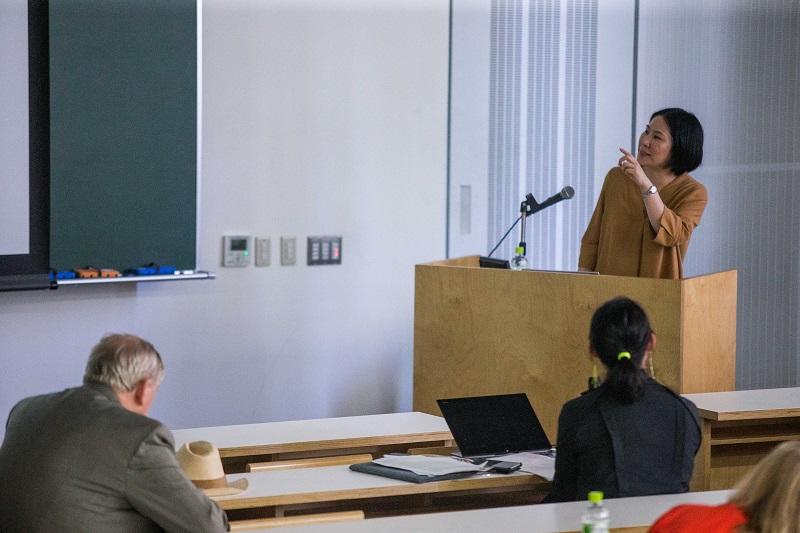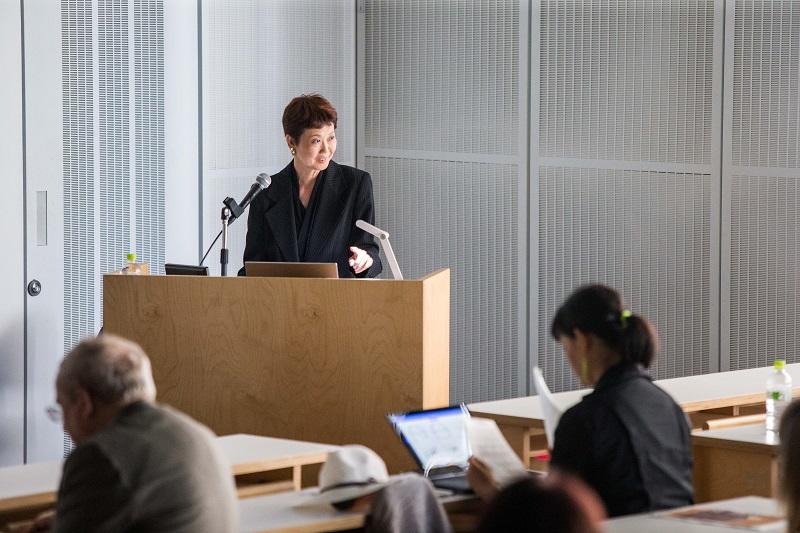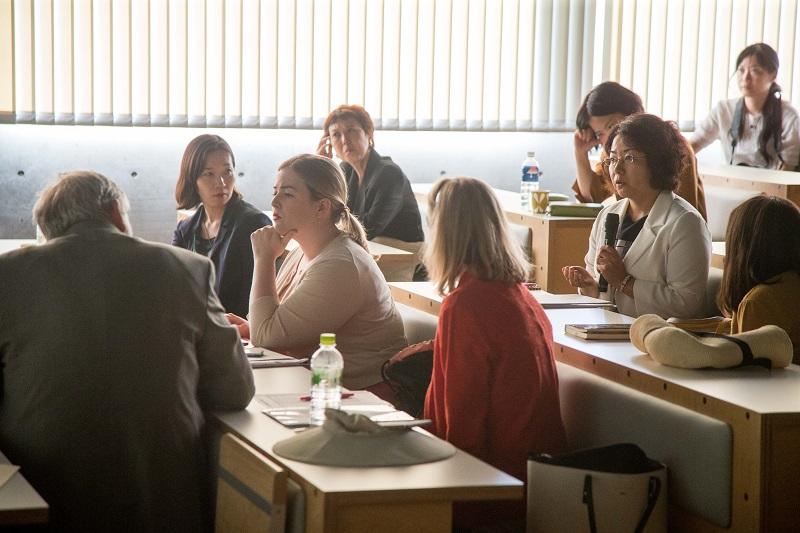2017.10.03
LCCG・GHC共催シンポジウム "Global Costume & Global Art" / LCCG・GHC Jointly-Hosted Symposium Series "Global Costume & Global Art"
7月26日(京都)、7月29日-30日(福岡)、8月5日(東京)、Global Costume & Global Art と題してLCCG・GHC共催シンポジウムを開催しました
7月26日京都シンポジウム Global Circulations and Transformations: Art and Textile in East Asia 1540-1760 [循環と変容 1540 -1760 年の世界と東アジアの美術・染織品]
2017年7月26日に京都工芸繊維大学で開催されたシンポジウムは、『循環と変容』と題して、16世紀から17世紀までの美術とテキスタイルの世界的な循環(サーキュレーション)の中における日本の位置を探求するものであった。京都工芸繊維大学の井戸美里氏(GHC)、並木誠士氏との共同主催で開催された。 最初に、プリンストン大学のトーマス・ダコスタ・カウフマン教授が基調講演をされた。講演の中で特に強調されたのは、アジア側の受容が「選択的」であり、「部分的翻訳」と称したほうがよい、受容側の主体性が強いものであった点である。その一方で、氏は各地・各国の美術品が独自展開をしてそれぞれを共通機軸で比較することはできないという意見には反対であり、各地の美術品はつながりあい、共約可能「Commensurableであるということを主張された。 続いて、井戸美里氏が「花鳥画」、鷲頭桂氏が日本外で製作されたと考えられる「花鳥屏風」、吉田雅子氏が「花鳥模様の刺繍布」、鵜飼敦子氏が「金唐革と金唐紙」を取り上げて発表をした。どの発表も、とりあげた美術品の生産・流通過程の一部に日本がかかわっているものの、世界的な繋がりがその背後にあることを浮き彫りになり、美術品の地理的区分の見方が刷新されたおもいであった。同時に、横のつながりを探求している研究者らが一堂に会すことで、それぞれの発表者が疑問におもっている点(取り上げられたモティーフがあらわそうとしたものなど)についても、活発に意見が交わされ、あたらしい繋がりも見いだされた。その点でも実に有意義なシンポジウムであった。
7月29日―30日シンポジウム Global Costume: Kosode, Dofuku, Banyan,Kebaya and Japanse Rok 1500‒1850. A dialogue of Global Circulation between Art History, Economy and Material Culture[グローバルコスチューム:小袖、胴服、バニヤン、クバヤ、ヤポンセ・ロック 1500-1850年 グローバルな循環をめぐる美術史・経済史・物質文化史の対話]
九州大学西新プラザで行われた一日半にわたる会議は、シンポジウムシリーズのメインイベントであった。福岡市美術館の岩永悦子氏、九州大学の青野純子氏との共同主催で開催された。16世紀~19世紀に異なる文化が対立・折衝しあう場にあった衣を、様々なアプローチから取り上げる会議であった。とくに、日本と結びつきのある衣裳を世界史的にとらえることを目指し、胴服・小袖・バニヤン・ケバヤ・ヤポンセ・ロックといった衣に着目し、着用した人々と着用背景が探られた。 最初にダコスタ・カウフマン氏が、「ズボンTrousers」を例に衣がいかに世界史的にとらえられるかを述べた。取り上げた「ズボン」を日本の視点からみると一般化が覆ることなど、鋭い指摘が質疑でなされた。 第一のパネルでは、岡美穂子氏がイエズス会士の服を、そして杉浦未樹が天正少年使節がポルトガルやイタリア来訪時に着用した和装を取り上げ、それらが当時の着用スタイルを再解釈したものであったことを述べた。さらにクレア・クーパー氏が16-17世紀の日本で描かれた「南蛮人」像が、スペイン・ポルトガル人そのものではなく、いかに当時の日本に近しい拠点であったゴア・マカオ・ルソンなどの人々の像と結びついていたかを明らかにした。 続くパネルは、模様に注目して衣の地域横断的な繋がりに迫った。アリアネ・フェネトー氏が18世紀にコロマンデルで製作された松竹梅模様のバニヤンを詳細にとりあげ、日本服飾史の専門家も交えて違いや繋がりについて討論がなされた。さらに鈴木桂子氏は伊勢型紙が世界的に織物製作に使われた点を述べた。 三番目のパネルは岩永悦子氏とピーター・リー氏が「ペラナカン装束」を取り上げた。このパネルでは、シンガポールや東南アジアの港町においては様々な地域の要素を取り入れて装うのが通常で、それらの要素は固定的ではなく「みせびらかしたり」「わざと着崩す(固定的な記号でわかるようなファッションをしない)」ということもよく行われ、異文化要素の取り入れは、貧富を問わず個人のレベルで頻繁におこなわれていた点があらためて強調された。パネルの最後では、両氏の関連コレクションからの染織品・衣裳のデモンストレーションが行われ、参加者は実物に触れながら活発に議論しあった。 翌29日午前ちゅうの最後のパネルで午前中美術史家のPillod氏と青野純子氏が発表を行った。見事なプレゼンテーションを通じて、画家たちが服飾品のディテールを通して表象したかったことが議論された。とりわけ青野純子氏の18世紀オランダにおけるヤポンセ・ロックを着用した一連の肖像画について、一日目の議論に関連する質問やコメントが相次ぎ、会議のよいしめくくりとなった。 総合討論で会議の要点や今後の計画が述べられたあと、午後には九州国立博物館において、狩野内膳作の南蛮屏風と、日本外で製作されたとみられる花鳥屏風の二つを特別閲覧した。九州国立博物館の学芸員の方々の多大な協力に感謝申し上げたい。
8月5日
最後の研究会は東洋文化研究所で開かれた。東京大学の後藤絵美氏(LCCG)・鵜飼敦子氏(LCCG・GHC)に運営を全面的に補助いただいた。プリンストン大学のダコスタ・カウフマン教授と、企画者の杉浦未樹が「コスチュームのグローバルヒストリー」のアプローチについてプレゼンを行った。カウフマン教授は、「ズボン」を主題に美術素材を使いながらいかに衣裳の世界史を横断的に叙述できるかを発表した。これに対し、杉浦は布と衣のグローバルヒストリーの代表的研究を美術史や経済史などアプローチごとに取り上げ、焦点となるプロセス、フィールド、アクターにずれがあり、これらを再調整し接合することで実のある共同研究ができることを主張した。これに対して羽田正教授とピリオド教授は、実践的な立場から、研究理解に役立つようなコメントを行い、続く質疑応答でも有意義な議論が行われた。
(杉浦未樹)
The symposium series “Global Costume & Global Art,” jointly sponsored by LCCG and GHC, was held on July 26 in Kyoto, July 29-30 in Fukuoka, and August 5 in Tokyo.
July 26 Kyoto Symposium “Global Circulations and Transformations: Art and Textile in East Asia 1540-1760”
The symposium held at the Kyoto Institute of Technology on July 26, entitled “Global Circulations and Transformations,” inquired into the place of Japan in the global circulation of art and textiles from the sixteenth to seventeenth century. It was co-hosted by Dr.Misato Ido (GHC) and Professor Seishi Namiki of the institute. First, Professor Thomas DaCosta Kaufmann of Princeton University gave the keynote address. He emphasized that reception of objects of art by the Asian side was “selective.” This can be called “partial translation,” and the reception side demonstrated the strength of their agency. Professor Kaufmann opposed, on the other hand, the belief that art objects in each region and country develop uniquely and thus cannot be compared using common criteria. He argued that there are connections between art objects of each region, which are “commensurable.” Next, Dr. Ido gave a presentation on “bird-and-flower paintings,” followed by Dr. Katsura Washizu of Kyushu National Museum on “bird-and-flower folding screens (byobu)” that are believed to be produced outside Japan. Professor Masako Yoshida of the Kyoto City University of Arts then presented on “bird-and-flower patterns on embroidered cloths” and Dr. Atsuko Ukai of the University of Tokyo discussed “Japanese gilded leather and paper.” The presentations highlighted the characteristic that while the processes of production and distribution in the presented art works all were associated in part with Japan, global connections underlie them. This feature provides a new way of understanding the geographic division of art works. Because the symposium enabled researchers investigating interdisciplinary connections to gather and meet in one place at the same time, they could vigorously engage in discussion about questions (e.g. interpretation or representation of motifs or patterns of art works mentioned in the presentations) raised by the presenters, and see new connections. This made the symposium a meaningful conference.
July 29 - 30 Kyushu Symposium “Global Costume: Kosode, Dofuku, Banyan, Kebaya and Japanse Rok 1500‒1850. A dialogue of Global Circulation between Art History, Economy and Material Culture”
This day-and-a-half conference, held at Kyushu University’s Nishijin Plaza, was the main event of the LCCG/GHC “Global Costume & Global Art” symposium series. It was co-hosted by Dr. Etsuko Iwanaga of the Fukuoka Art Museum and Associate Professor Junko Aono of Kyushu University. Using various approaches, the conference examined clothing, an area of confrontation and negotiation between different cultures, from the sixteenth to nineteenth century. It especially sought to examine costumes connected with Japan from the global perspective. Focusing on clothing such as dofuku (a Japanese outer garment worn by men, considered to be the basis of the haori), kosode (a traditional Japanese garment considered to the forerunner of the kimono), banyan, kebaya, and Japanse Rok (from the Dutch for “Japanese robe,” a kimono-like indoor gown worn by European men in the seventeenth and eighteenth century), the symposium examined the people wearing the clothing and the background of their use.
Professor Kaufmann first discussed “trousers” as a case study of how clothing is viewed from a perspective of global history. Sharp observations such as how general notions and usages of “trousers” are overturned by the Japanese perspective were offered during the question and answer period.
During the first panel discussion, Associate Professor Mihoko Oka of the University of Tokyo discussed clothing worn by members of the Society of Jesus. Next, Professor Miki Sugiura of Hosei University examined clothing worn by delegates of the Tensho embassy when they visited Portugal and Italy. The two presenters argued that the clothing worn by the two groups reinterpreted the styles worn during their times. Next, Ms. Claire Cooper revealed how images of “Nanbanjin” (Japanese term for Portuguese and Spaniards who visited Japan from the end of the Muromachi period to the Edo era) depicted in Japan in the sixteenth and seventeenth century did not actually show people from Portugal or Spain themselves, but were actually had connections to images of people from places such as Goa, Macao, and Luzon, which were centers of trade closely tied to Japan at the time.
The next panel discussion inquired into cross-regional connections in clothing, with a focus on patterns. Ms. Ariane Fennetaux (University of Paris-Diderot) examined in detail banyan having the traditional Japanese motifs of pine, bamboo and plum trees produced in Coromandel Coast in the eighteenth century. Her presentation drew discussion from experts in Japanese clothing history about differences and connections in attires. Next, Professor Keiko Suzuki of Ritsumeikan University discussed how Ise-katagami stencils were used in the production of textiles worldwide.
For the third panel discussion, Ms. Etsuko Iwanaga and Mr. Peter Lee (Peranakan Museum) discussed “Peranakan costumes.” The discussion revealed how various local elements of attire were ordinarily incorporated by people in the port towns of Singapore and Southeast Asia. These elements were often used to “show off” (by not using fixed elements) or to purposefully adopt a “worn out of shape” style (by purposefully not adopting a fashion in which fixed symbols could be understood). The presenters re-emphasized that elements of different cultures were frequently incorporated by people at a personal level, regardless of whether they were rich or poor. The panel concluded with a collaborative demonstration of weaving, dyeing, and costuming by the two panelists. Participants engaged in active discussion while touching real costumes.
The final panel discussion in the next morning, on July 30, featured presentations by Professor Elizabeth Pilliod (Rutgers University), an art historian, and Professor Junko Aono. The outstanding presentations elicited discussion on what artists sought to represent through details of clothing accessories. Professor Aono’s presentation on portraits of people wearing Japanse Rok in eighteenth-century Netherlands especially drew questions and comments related to discussions held during the first day of the conference, bringing the symposium to a meaningful conclusion.
After a round of general discussion summarizing the main points of the conference and outlining future plans, participants were given access to special exhibits at Kyushu National Museum of Kano Naizen’s Nanban folding screens and flower-and-bird folding screens produced outside Japan. We wish to take this opportunity to express our deep gratitude to the curation staff of Kyushu National Museum for their cooperation.
August 5
The final symposium was held at the Institute of Advanced Studies on Asia of the University of Tokyo. Associate Professor Emi Goto (LCCG) and Dr.Atsuko Ukai (LCCG・GHC) of the University of Tokyo assisted overall with its implementation. Professor Kaufmann of Princeton University and Professor Miki Sugiura gave presentations on approaches of “the global history of costumes.” Using art materials from the main theme of “trousers,” Professor Kaufmann discussed how the global history of costumes can be written across different countries and cultures using art materials. In contrast, Professor Sugiura examined representative global history studies of textiles and clothes from approaches of both art history and economic history. She argued that there were differences in the processes, fields, and actors under focus, and that fruitful collaborative research is possible by realigning and joining these elements. Professor Masashi Haneda of the University of Tokyo and Professor Pilliod provided comments on these subjects from a practical standpoint that were beneficial to understanding research. Finally, the participants engaged in meaningful Q&A.
(Miki Sugiura)



























